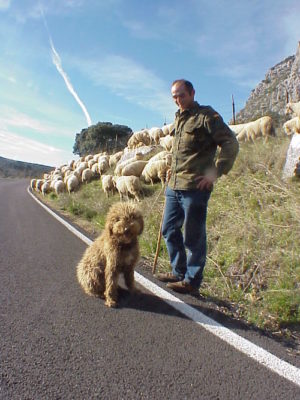
Scroll down to the video to get you in the mood:
With tongue in cheek, we use Rodney Dangerfield’s signature comment, “No respect” to mention that ancestors of the Spanish Water Dog were documented on the Iberian Peninsula in 1110 AD, and yet the dog native to Spain wasn’t recognized by Spain’s kennel club until 1985. No respect for a dog that was part of the ancient practice of transhumance so important to the pastoral life of Spain.
To offer a bit of background, “La Mesta” was a powerful association of sheep ranchers in 18th century Spain. Its sheep were transhumant, meaning they were moved from the south of Spain to the north of Spain, and back again, always looking for fertile grazing areas.
A modern day version of this can be seen in the video below, a “parade of livestock” that takes the route (known as “Canada Real”) that once cut through undeveloped countryside on their way to winter grazing pastures in southern Spain. This modern and symbolic event has happened every year since 1994. Shepherds pay a symbolic charge in acknowledgement of a 1418 agreement with the city council that set a fee of 50 maravedis – medieval copper coins – per 1,000 sheep brought through the central Sol square and Gran Via street:
What the video doesn’t show are the dogs that were part of this movement of animals known in Spain as “Trashumancia,” an economical way to ensure that the sheep got enough fresh food throughout the year. Today there is a good deal of lore surrounding the Spanish Water Dog’s use in the seasonal migration of flocks over 300 miles, but back when French Napoleonic forces occupied Spain, the “Trashumancia” began to fade away.
The rise of the Chinese wool market and cheap synthetic alternatives saw ranchers getting less and less for their wool. Shepherds in other parts of Spain started to replace their SWDs with other breeds like the German Shepherd Dog and Belgian Shepherd, but in the southern part of Spain, especially Cadiz and the mountains of Malaga in Andalucia, Spanish Water Dogs were still used because of their ability to work in the mountains. Some fisherman, especially those in the ports of Seville, Algecieras and Malaga, started to use the Water Dog to tow boats into shore, while in the the northern part of the country, the breed was used to help fisherman with their nets.
Had it not been for the shepherds and environmentalists who never stopped seeing sheep herding as a valuable tool for conservation, transhumance would have ended altogether. Instead, it is experiencing a resurgence. Many shepherds are now supported by a network of activists and conservationists, and to show the harmony that can exist between the old and the new, the Shepherds benefit from trails maintained by hikers, mountain cyclists and horseback riders who in turn, enjoy a protected natural environment afforded by the drover roads.
As for the Spanish Water Dogs, the breed was “reintroduced” in 1975 through the efforts of breeders, Santiago Montesinos and Antonio Garcia Perez. Standards were written, and at long last, the breed was accepted first by the Spanish Kennel Club, and then by FCI. In 2015, the American Kennel Club also recognized the breed also known as the Perro de Agua Español, Turco Andaluz, Perro Turco, and Andalucian Turk.
Image of a working Spanish Water Dog from Wikicommons
